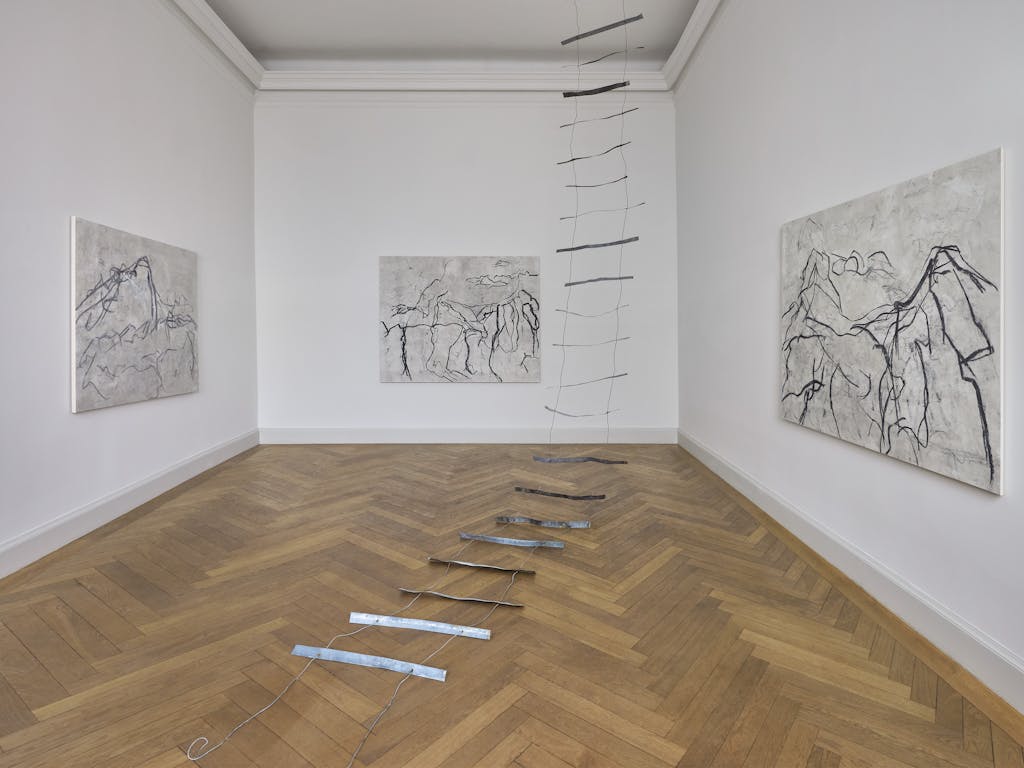Beatrice Caracciolo
SENTIERO
28 Jan 2023 - 1 Apr 2023
Berlin

Beatrice Caracciolo’s works shift between figurative and abstract, between drawing and painting. This is true for both her paintings and objects as well as expansive installations. With a selection of Caracciolo’s most recent works, this first exhibition at KEWENIG of the Italian artist’s work sheds light on the processes that lead to her compositions and integrate material and space.
Caracciolo’s paintings are riddled with lines, drawn and painted, delicately interwoven or as bold strokes. Sometimes they appear to be executed with vigour, sometimes meticulously, gestural, restless, yet always deliberate. The lines form shapes and signs; they represent a moving structure that does not deny its two-dimensional state, even though they might, at the same time, achieve considerable depth. The lines seem to invite one to follow them like tracks or a path (Ital.: sentiero).
For each of her diverse series of works, the artist carefully selects her palette of colours and techniques, which, although seemingly restrained, do not fail to convey the impression of urgent density, of dramatic dynamism. Among other media, she works with graphite, oil pastels, tempera, pigment and chalk, sometimes supplementing these with barely recognisable, fragile paper collages. Caracciolo uses paper as a multi-layered support, later mounted on canvas. Earlier markings are hidden beneath the network of lines, hidden cartographies that have retained their presence throughout the creative process.
What initially appear to be fleeting sketches in the 'Combattere' series (Eng.: Fight, 2021) soon prove to be compositions on paper of clear-cut lines that are reminiscent of the automatism of the Surrealists. Materiality plays a special role here – the lines are scratches that remove the top layer of pigment and expose the one underneath. In 'Combattere', the artist also uses another technique and, with it, evokes an astonishing degree of spatiality. By creating collages of thin, differently painted papers, she manages to add texture and depth in the free arrangement of lines. It is the abundance of these traces that illustrates how Caracciolo, with concentrated vigour, works on her themes to create numerous pictures.
In contrast, the series 'Esistenze' (Eng.: Existences, 2021) appears strongly reduced and apparently inspired by Chinese calligraphy. Only a few markings, partly as lines, partly as painted collage, may depict motifs from nature, but instead take on the appearance of autonomous signs that radiate sublimity in their transcendence. For 'Il bosco lontano III' (Eng.: The Distant Forest, 2022), a triptych, Caracciolo chose a reddish palette and worked the canvases over the entire surface with brushstrokes, washes and scratches. The markings transform nature into something abstract and negate three-dimensionality, while the variety of painterly devices leads the viewer away from any illusion into the atmospheric depths of a forest.
While the artist’s personal encounters are a characteristic feature of her 'Malinconia' series (Eng.: Melancholia, 2022), the 'Sentiero' series (Eng.: Path, 2022) comprises vaguely figurative references, which draw on, among other things, Pulcinella depictions by the Italian baroque painter Giovanni Domenico Tiepolo and are motivated by the drawings of Joseph Beuys. Caracciolo addresses emotional experiences, presents scenes from nature or art history, or draws on her imagination. In this thematic body of works, too, she reduces her models to markings that illustrate their essential character and with them develops her own distinctive abstract language.
Beatrice Caracciolo’s 'Costruzioni' (Eng.: Constructions) made of zinc sheets also reflect her unmistakable graphic approach. She has been working with this material since the 1990s. The Balkan War in former Yugoslavia brought images of its victims, whose homes were bombed or who had to flee, seeking shelter in makeshift dwellings built of zinc sheets. This reference imbues the metal with symbolical meaning. It is a material that has no metallic sheen but is nevertheless beautiful in its makeshift crudeness – and now visually conveys the idea of destruction, reconstruction, shelter and protection. The matt opacity of the sheet metal is reminiscent of the ‘poor’ materia used in Arte povera by artists like Jannis Kounellis.
The metal sheets in Caracciolo’s constructions lack any uniformity – the shades of grey are indeterminate, the surfaces scarred by time and weather. Each of the sheets is a fragment, and the artist joins many of them together like a collage to create her wall objects and installations. A 'Ladder' (1996) hanging from the ceiling in the middle of the room, thin zinc plates as rungs, connected with wire only, is unstable and its goal is indeterminate. A purely graphic space, in which the viewer finds moving about a challenge, is abandoned here and transformed into a real space. This applies all the more, of course, to 'Torrente' (Eng.: Torrent), where the construction, like a line, traverses several rooms of the gallery, a flexible ribbon of zinc plates that follows the architecture of the house, seemingly defying gravity, as an active, wandering, searching form. And yet, it can be said, these zinc works also acquire the status of paintings in interplay with the artist’s pictures, her drawings and paintings, which reference history and at the same time bear within them the ambivalence of the material.
Beatrice Caracciolo’s observation of the world is incisive and her exploration thereof profound. In this exhibition, we experience far more than the formal extension of what the artist perceives. It seems as if history, images and experiences are, for her, a spiritual opportunity for visual expression. She intensively works on various themes in her different series until the visual imagery comes to life, – an imagery that is relevant to our time and strongly poetic.